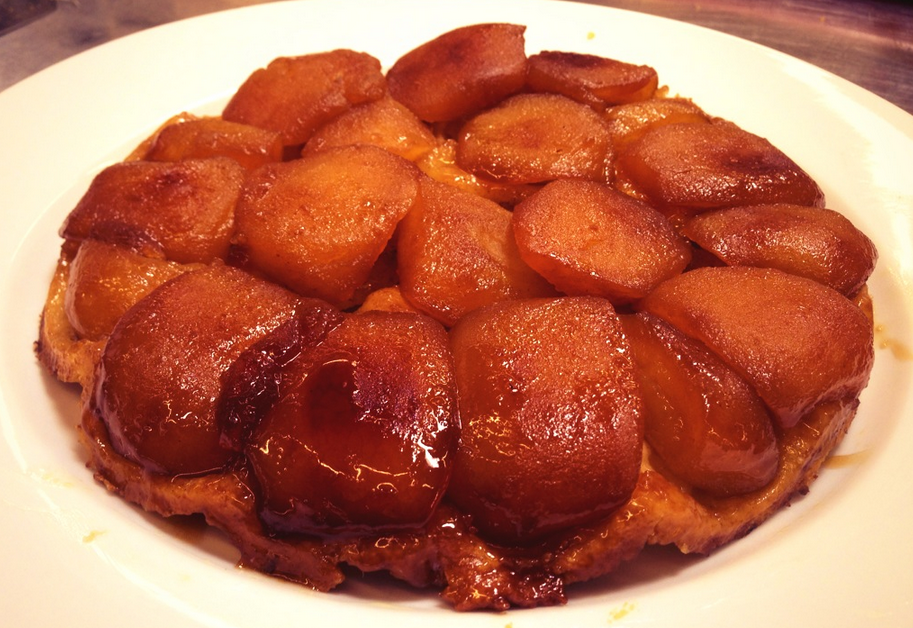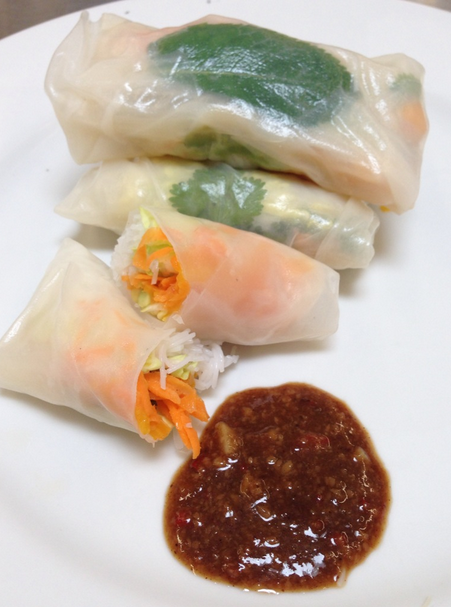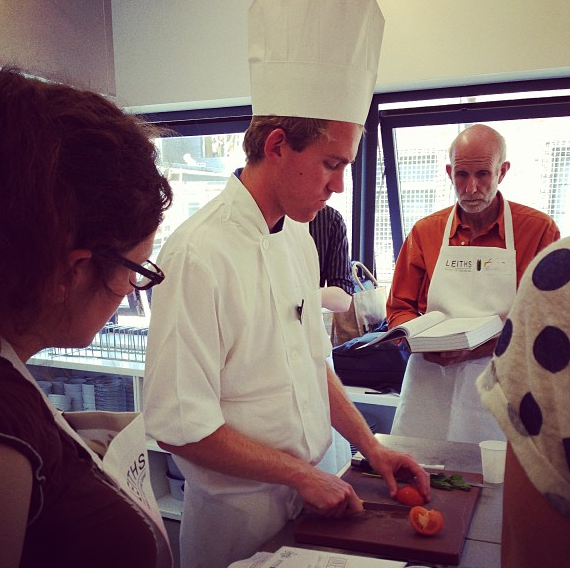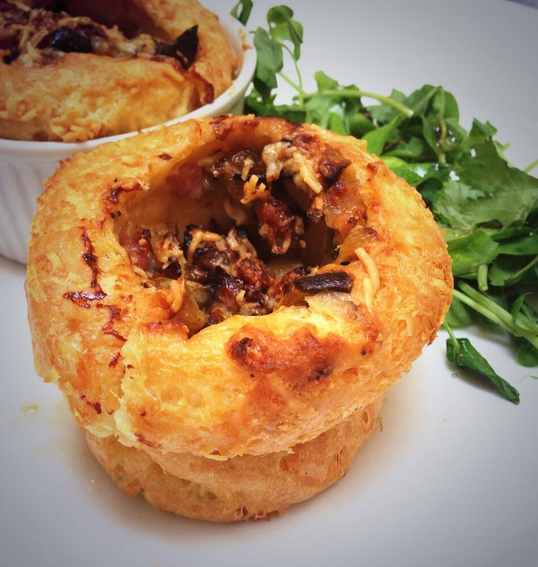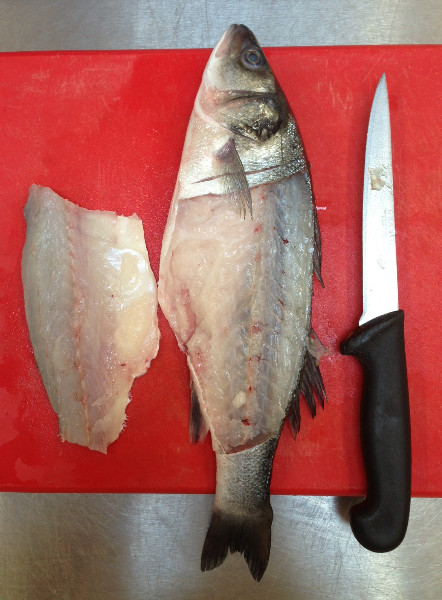Leiths Cookery Week – day two
So, if you’ve read Friday’s preview, you will know that this week I’m doing a day by day review of my week at Leiths School of Food and Wine. This is the round up of Tuesday 9th on the white intermediate course.
Tuesday started off in to the demo room, where we watched two sessions – one on bread and one on meringue. The recipes demonstrated were a quick Italian bread (just one rise), a beer bread, and pecan sticky buns, which demonstrated an enriched dough. The meringue section covered Swiss meringue (beaten egg white plus caster sugar), and we watched our chef make individual pavlovas served with rhurbarb fool and compote, as well as walnut and meringue cake.
The Italian bread, which was more of a flat bread, was amazingly easy – it took minimal time and could just be shaped and proved once before baking. We learned that adding flavour to a bread should happen just before you shape and prove – so with this one, you can knead in your addition (be that caramelised onions, rosemary, olives etc) in the first bit of kneading, but with normal breads it’s after the first rise. When making breads with wholemeal flour, such as the beer bread, it’s nice to hold back the bran after sieving and use to decorate the loaf before baking. I didn’t find the beer bread hugely memorable, but the pecan sticky buns were very cool. Adding butter to breads acts as a preservative in addition to adding richness (though they’re still best eaten on the day).

Kneading breads with a dough hook in a Kenwood or a KitchenAid is fine but it’s very important not to overwork it – kneading is all about stretching out the gluten and if overworked, those gluten strands will snap and the dough will become tough. With enriched doughs that include butter, you can melt the butter in the warm measured out liquid first in order to incorporate the fat evenly. Similarly when using fresh bakers yeast (which actually really does have a mushroomy texture!) you can ‘cream’ the yeast, by adding a few drops of your already measured liquid to it and mixing it with a teaspoon until it’s all smooth and combined. The amont of butter in the pecan buns is FRIGHTENING – it includes 225g of butter, which you generously smear all over the bottom of two tins. But as an occasional treat, they’re wonderful and not too tricky either.

I was already very familiar with making meringues, and the individual pavlovas were a real treat. Adding a little bit of vinegar and a small amount of corn flour will help achieve a mallowy texture, which helps achieve that wonderful chewiness you get in meringues. The rhurbarb fool was a perfect addition too.
I’d never made a meringue cake before, which is literally two small smooth even pavolvas sandwiched together with cream and fruit (or similar). The difference when making the cakes is that you cook them on a much higher heat and for less time, so you end up with a coloured but still fragile shell with the most amazing chewy, mallowy middle. Adding nuts to meringue is lovely, but you need to ensure the nuts are small enough to remain suspended in the meringue. You can pulse them up a blender but only till they’re about the size of almond nibs. When pulsing up nuts, add a tablespoon of sugar (the sugar from your meringue recipe ideally, so grind the nuts before you make the actual meringue). The sugar absorbs some of the fat and makes it easier to work with. Don’t over grind them to the point of greasiness. Meringue only holds its shape for a certain amount of time and is delicate, so folding the nuts in quickly and delicately is important. You only have so long before it liquifies.

In the afternoon, we started off a raisin hazelnut loaf, which was left to prove in the fridge overnight. More on that tomorrow! We also made mint and tomato salsa (an unexpectedly amazing combination), potatoes en papillote (potatoes cooked in a small greaseproof parcel), and a rack of lamb, which we stripped and prepped ourselves. Cooking something en papillote is fantastic – it’s a great way to seal in flavours (we chucked in rosemary, olive oil, and garlic) and it does something between steaming and roasting. Since greaseproof is porous, it’s a very good paper to use as it means the potatoes go a bit crisp. The lamb was a challenge but I had no idea how much more expensive it it to get rack of lamb pre prepped. We boned it, removed the sinews, and then stripped the bones neatly for presentation. I learned a lot on day two – it was a superb day. The staff at Leiths are almost faultless – they’re very patient, very keen to show you things, and they’re incredibly knowledgeable.
Five things I learned today:
- The only thing that can truly kill yeast is excess heat – so always cool down liquids to blood temperature before adding to yeast.
- The first rise when making bread is about developing flavours – a slow rise (such as overnight in the fridge) will produce a stronger, yeastier flavour. You can leave it rising for up to two days. Always leave it for 20 mins to check the yeast is alive before transferring to the fridge.
- If a recipe calls for a kind of yeast you don’t have you can substitute accordingly – 30g fresh yeast = 15g dried yeast = 7g fast action yeast (the kind in the sachet)
- To check when you’ve kneading enough, make a taught area and poke it lightly. If the dent comes out, it’s done. To check when it’s proved enough, pick a small discreet area and gently poke it. If the dent stays in, it’s ready to go into the oven.
- Add a small pinch of salt to fresh egg whites when making meringue. Slightly older egg whites are slightly better for meringues.
Tomorrow I’m writing up Wednesday, which involves a lot of pastry. And some duck breasts. Quack quack.
Disclosure: I contacted Leiths about their courses and arranged for a discount on their intermediate course in exchange for an honest review of my experience, which I have chronicled over a series of posts.

